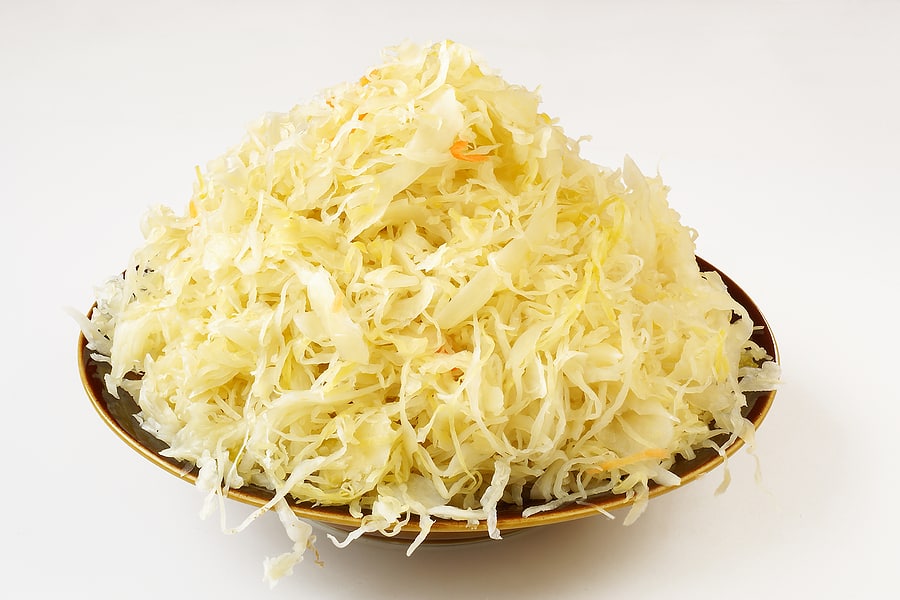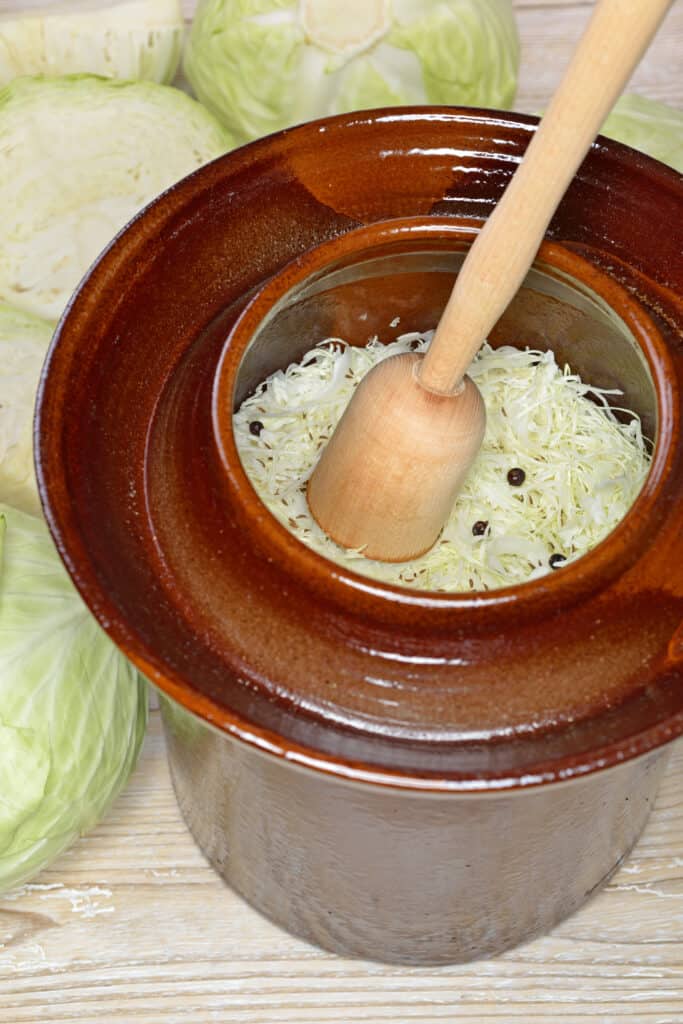
Sauerkraut is pickled white cabbage.
How to make sauerkraut in a stone crock
Finely sliced cabbage is placed in a stone crock, a hardwood keg, or a barrel and layered with salt. As the layers are built up, they are pounded down with a wooden mallet. Then the layers are covered with a clean cloth, a board, and a heavy stone.
The mix is set aside in a cool place to ferment. In a few days, brine, tiny bubbles, and a layer of scum will rise above the cloth. The brine and scum are removed every couple of days until the bubbles no longer appear. Then the kraut is made.

How to make sauerkraut in a large canning jar
- Have at hand a very clean wide-mouth canning jar.
- Cut a head of cabbage into quarters, then wedges, and then crosscut in thin ribbons. ribbons.
- Place the cabbage to a large bowl and sprinkle with salt. With very clean hands, work the salt into the cabbage by massaging and squeezing it. The cabbage will become limp and coleslaw like after 5 to 10 minutes. Add a flavoring such as caraway seed if you like.
- Pack the cabbage into the canning jar. Tamp down the cabbage with a spatula. Add any liquid released by the cabbage into the jar. Place a large cabbage leaf over the top of the sliced cabbage.
- Place a smaller jar or glass into the mouth of the canning jar atop the cabbage. Weigh down the jar smaller jar with marbles. The cabbage must be submerged below the liquid in the larger jar.
- Cover the mouth of the larger jar with a cloth and secure it with a rubber band. Air can flow into the jar by dust and insects will be excluded.
- Over the next 24 hours, press down on the cabbage with the smaller jar. The cabbage will release more liquid covering the top of the cabbage. If the cabbage is not covered with liquid, add very lightly salted water to cover the cabbage.
- Let the cabbage ferment for 3 to 10 days. Ferment the cabbage out of direct sunlight in a cool room, about 65°F to 75°F. Check the cabbage twice a day to be sure it does not float up above the liquid.
- Do not be alarmed if you seed bubbles or foam on top of the liquid during fermentation. If you see mold, remove it immediately. Do not eat moldy cabbage or sauerkraut.
- Begin tasting the sauerkraut after three days. When the taste is to your liking remove the smaller jar and weight and place a screw-top cap on the larger jar or sauerkraut.
- Sauerkraut will keep for 8 weeks refrigerated. Discard if smells bad.
About sauerkraut
- Sauerkraut is said to have originated somewhere in ancient Mongolia or China were nomadic horsemen learned to preserve cabbage in brine so that they would have a ready meal on their far-flung journeys.
- The Mongols and the Huns brought their pickled cabbage to Europe in the fourth century. There it evolved into sauerkraut in Germany and Alsace. Sauerkraut means sour cabbage in German. There is a similar dish in Manchuria and China today. It is called suan cai which means sour vegetable.
Sauerkraut
Instructions
- Remove ragged or tough leaves from the white cabbage head.
- Shred the cabbage fine. Use a shredder or an old fashioned “kraut board.”
- Weigh the cabbage. You will use 2 teaspoons of pickling salt for each pound of cabbage.
- Place a layer of salt in the container: a sauerkraut crock, stone crock, or hardwood keg.
- Place 2 or 3 layers of shredded cabbage over the salt.
- Place a second layer of salt over the cabbage.
- Continue layering until you are 4 or 5 inches from the top of the container.
- Pound the mix gently with a wooden mallet.
- Top with a layer of salt.
- Place a clean hardwood board or a plate over the top of the cabbage and weigh it down with a rock or other weights.
- Tie a clean muslin cloth or layers of cheesecloth over the top of the container.
- Store in a cool place (45 to 60°F) to ferment.
- In a few days, a brine, tiny bubbles, and scum will appear above the board or plate.
- Skim the brine and scum away every couple of days until the tiny bubbles on longer appear. This could take a month.
- When the bubbles no longer appear, your sauerkraut is made.
- Sauerkraut can be spiced as you make it with juniper berries, peppercorns, bay leaves, caraway seeds, dill, or allspice.
Notes
STORING SAUERKRAUT:
You can not freeze sauerkraut. So it is best to store it in vacuum-top canning jars.
- Fill each vacuum-top canning jar with juice and kraut to within a half inch of the top.
- Wipe the sealing edge. Dip the metal disk lid in boiling water, place on top, and screw the metal band tight.
- Place the canning jars on a rack in a deep kettle and cover with hot water.
- Put the lid on the kettle and bring to a gentle boil for 35 minutes.
- Remove the jars from the water and set on a drying rack or wooden counter and cool for 12 to 24 hours.
SERVING SAUERKRAUT:
- Serve steamed sauerkraut with pork, sausages, ham, turkey, boiled dinners, duck, or any meat.
- Serve sauerkraut raw as a relish or condiment with meat dishes, bratwurst, or hot dogs.
- Serve sauerkraut as a salad: dress with oil and onions; combine with a vinaigrette sauce, mayonnaise, or Thousand Island dressing to taste.
- Serve cooked sauerkraut with potato noodles.
More kitchen tips:
Bring your harvest to the table. Kitchen prep tips and easy recipes for the vegetables you grow. Click below for vegetable prep and recipes you can use now.
- Almonds
- Apples
- Apricot
- Aprium
- Artichoke
- Arugula
- Asparagus
- Avocado
- Bamboo Shoots
- Banana
- Basil
- Beans, Dried
- Beans. Long
- Beans, Shell
- Beans, Snap
- Beets
- Bitter Melon
- Blackberry
- Bok Choy
- Broccoli
- Broccoli Raab
- Brussels Sprouts
- Cabbage
- Cardoon
- Carrots
- Cauliflower
- Celeriac
- Celery
- Chard
- Chayote Squash
- Cherimoya
- Cherries
- Chestnut
- Chickpea
- Chinese Cabbage
- Chives
- Cilantro
- Citron
- Clementine
- Collards
- Coriander
- Corn, Sweet
- Corn, Baby
- Corn Salad, Mache
- Cranberry
- Cress
- Cucumber
- Daikon
- Dandelion
- Dill
- Eggplant
- Endive, Belgian
- Endive and Escarole
- Fava Beans
- Fig
- Florence Fennel
- Garlic
- Ginger
- Grapefruit
- Grapes
- Guava
- Horseradish
- Jerusalem Artichoke
- Jicama
- Jujube
- Kale
- Kiwifruit
- Kohlrabi
- Kumquat
- Leeks
- Lemongrass
- Lemons
- Lettuce
- Lime
- Mache (Corn Salad)
- Mandarin Orange
- Mango
- Maple Syrup
- Marjoram
- Melons
- Michihili
- Mint
- Mizuna
- Mushrooms
- Mushrooms, Cremini
- Mustard Greens
- Napa Cabbage
- Nectarine
- Okra
- Olives
- Olive oil
- Onions
- Oranges
- Oregano
- Parsley
- Parsley Root
- Parsnips
- Passion Fruit
- Pawpaw
- Peaches
- Pears
- Peas, Garden Snap
- Peas, Snow
- Pei Tsai
- Peppers, Chili
- Peppers, Sweet
- Persimmon
- Pineapple
- Pineapple Guava
- Plantain
- Plums
- Pluots
- Pomegranate
- Potatoes
- Prickly Pear
- Pumpkin
- Quince
- Radicchio
- Radishes
- Raspberries
- Rosemary
- Rhubarb
- Rutabaga
- Sage
- Salsify
- Sauerkraut
- Savory
- Shallots
- Sorrel
- Spinach
- Squash, Summer
- Squash, Winter
- Strawberries
- Sunchokes
- Sunflower
- Sweet Potato
- Swiss Chard
- Tangerine
- Taro
- Tarragon
- Thyme
- Tomatillo
- Tomato
- Turnip
- Turnip Greens
- Yams



